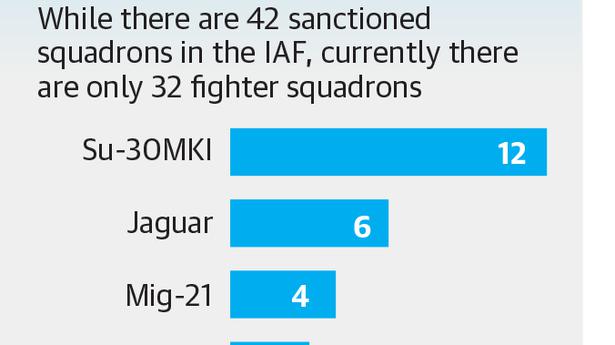
Explained | The dwindling fighter strength of the IAF
The Hindu
How is the Indian Air Force planning to increase fighter aircraft? Do the MIG-21 jets still have technical life left?
The story so far: In a tragic accident, a MIG-21 trainer jet of the Indian Air Force (IAF) crashed in Rajasthan last Thursday killing both the pilots onboard, Wing Commander M. Rana and Flight Lieutenant Advitiya Bal. This has once again put the focus on the MIG-21 jets as well as on the IAF’s fighter strength and modernisation.
The MIG-21 was inducted into the IAF in the early 1960s and since then more than 800 variants of the supersonic fighter were inducted into service. It remained the frontline fighter jet of the force for a long time. During this period, there were over 400 accidents involving the jet which claimed the lives of around 200 pilots. Currently, there are four MIG-21 squadrons in service consisting of the upgraded Bison variant. IAF officials have stated that there is technical life still left in them.
There are only four squadrons of the MIG-21 aircraft, the IAF informed the Parliamentary Standing Committee on defence as per a report tabled in March this year. “As and when the technical life is complete, we can’t keep them extra even for a day, and we don’t keep them either. Life extension is done for some aircraft. In that regard, we now have the Bison aircraft remaining, which are upgraded, but still old. There is no doubt about that,” an IAF representative told the committee.
With delays in new inductions, the IAF has been forced to continue the last four MIG-21 Bison squadrons in service. One squadron is set to be phased out in the next few months, while the remaining three squadrons are planned to be phased out in the next three years. This phase out was worked out much before last week’s tragic incident.
The IAF has an authorised strength of 42 fighter squadrons. As time passes, the drawdown is increasing as the total technical life is completed. However, the rate of new inductions is not matching the drawdown, depleting the overall number of fighter squadrons. Additionally, several frontline aircraft in the inventory including the Jaguars, MIG-29s will begin phasing out by the end of the decade. For instance, by 2027-28 the first of the MIG-29s, inducted in the late 1980s, will start going out.
In the last few years, the IAF has inducted two squadrons of the indigenous Light Combat Aircraft (LCA) Tejas and two squadrons of Rafale fighter jets procured from France which pushed the squadron strength to 32.
In January 2021, the IAF had signed a contract with Hindustan Aeronautics Limited (HAL) for 83 LCA MK-1A which it will start receiving from early 2024 onwards. Along with that the to-be-acquired 114 Multi-Role Fighter Aircraft (MRFA) will help arrest the drawdown, the IAF said.

“Writing, in general, is a very solitary process,” says Yauvanika Chopra, Associate Director at The New India Foundation (NIF), which, earlier this year, announced the 12th edition of its NIF Book Fellowships for research and scholarship about Indian history after Independence. While authors, in general, are built for it, it can still get very lonely, says Chopra, pointing out that the fellowship’s community support is as valuable as the monetary benefits it offers. “There is a solid community of NIF fellows, trustees, language experts, jury members, all of whom are incredibly competent,” she says. “They really help make authors feel supported from manuscript to publication, so you never feel like you’re struggling through isolation.”

Several principals of government and private schools in Delhi on Tuesday said the Directorate of Education (DoE) circular from a day earlier, directing schools to conduct classes in ‘hybrid’ mode, had caused confusion regarding day-to-day operations as they did not know how many students would return to school from Wednesday and how would teachers instruct in two modes — online and in person — at once. The DoE circular on Monday had also stated that the option to “exercise online mode of education, wherever available, shall vest with the students and their guardians”. Several schoolteachers also expressed confusion regarding the DoE order. A government schoolteacher said he was unsure of how to cope with the resumption of physical classes, given that the order directing government offices to ensure that 50% of the employees work from home is still in place. On Monday, the Commission for Air Quality Management in the National Capital Region and Adjoining Areas (CAQM) had, on the orders of the Supreme Court, directed schools in Delhi-NCR to shift classes to the hybrid mode, following which the DoE had issued the circular. The court had urged the Centre’s pollution watchdog to consider restarting physical classes due to many students missing out on the mid-day meals and lacking the necessary means to attend classes online. The CAQM had, on November 20, asked schools in Delhi-NCR to shift to the online mode of teaching.









